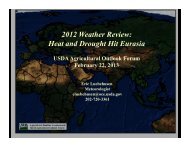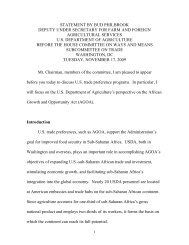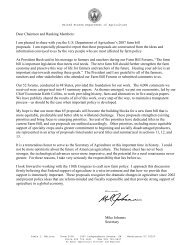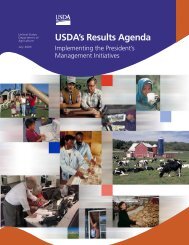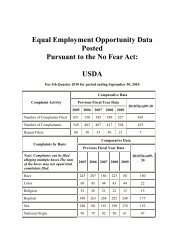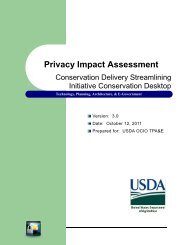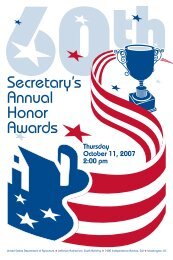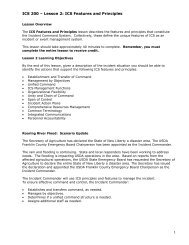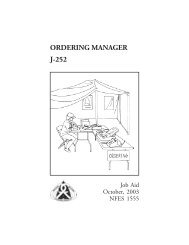Hawaii Clean Energy Initiative - US Department of Agriculture
Hawaii Clean Energy Initiative - US Department of Agriculture
Hawaii Clean Energy Initiative - US Department of Agriculture
- No tags were found...
You also want an ePaper? Increase the reach of your titles
YUMPU automatically turns print PDFs into web optimized ePapers that Google loves.
Bioenergy for<strong>Hawaii</strong>April 6, 2010Hawai`i State <strong>Energy</strong> OfficeMaria Tome, P.E.
Contents<strong>Hawaii</strong>’s <strong>Energy</strong> ChallengePieces <strong>of</strong> the <strong>Energy</strong> PuzzleOne piece: BioenergyBi<strong>of</strong>uels AssessmentBioenergy Master PlanSummary
The Magnitude <strong>of</strong> the Challenge50,000,000 barrels per year imported to <strong>Hawaii</strong>1,300,000 resident population38.46 barrels per resident per year42 gallons per barrel1615 gallons per resident per year365 days per year4.4 gallons per resident per dayHow much energy is this?
Person2,000 Calories / day7,937 Btu / day365 Days / year2,896,874 Btu / year1Car500 Gal. gasolineper year110,000 Btu / gallon55,000,000 Btu / year19<strong>Hawaii</strong>’sEconomy50,000,000 Barrels / yr5,800,000 Btu per barrel1,300,000 Res. pop.223,076,923 Btu / year /person in HIeconomy77
<strong>Hawaii</strong> <strong>Clean</strong> <strong>Energy</strong> <strong>Initiative</strong>:70% clean energy by 2030from Efficiency (30%) + Renewables (40%)Total GWh per year5000 10,000 15,0004365GWh5820GWh4365GWh30% <strong>Energy</strong>Efficiency40% Renewable<strong>Energy</strong>30% MaximumFossil Fuel20082020 2030
Transportation‣ Reduce Need to Travel (Land Use)‣ Transportation System Design– Congestion Reduction– Alternative Modes‣ More Efficient Vehicles‣ Vehicles Capable <strong>of</strong> UsingNon-petroleum <strong>Energy</strong> Sources‣ Alternative Fuels& Fueling Infrastructure– Liquid fuelso Ethanol, Renewable Gasolineo Biodiesel, Renewable Dieselo Biojet– Electricity from renewable sources,<strong>of</strong>f-peak– Gaseous Fuels (Hydrogen, Methane)<strong>Energy</strong> for TomorrowElectricity‣ <strong>Energy</strong> Efficiency First‣ Customer-Sited Generation‣ Combined Heat and Power‣ Development <strong>of</strong> Renewable <strong>Energy</strong>Resources– Solar– Wind– Biomass / Bi<strong>of</strong>uels– Geothermal– Hydropower– Ocean (OTEC & Wave)‣ <strong>Energy</strong> Storage‣ Smart Grids‣ Changes in Electricity Regulation– Delinking – from oil price– Decoupling revenues & sales– Customer Sited Generation
BioenergySUGAR CANE / GRASSESWOODSOLID WASTEOIL SEEDSALGAE
Bioenergy Master Plan, Appendix 2.2 – Infrastructure – Fig. 8
Previous Bioenergy Studieshttp://hawaii.gov/dbedt/info/energy/renewable/biomass
BUILDING A WORLD OF DIFFERENCE ®Bi<strong>of</strong>uels Assessment• Task 1 - Assessment <strong>of</strong> Existing <strong>Hawaii</strong> Biomass Feedstocks• Task 2 – Crop Assessment• Task 3 – Coordination with <strong>Hawaii</strong> State Agencies• Task 4 - Report on the Potential for Bi<strong>of</strong>uels Production‣ Ethanol‣ Biodiesel‣ Biomass-Derived Hydrogen
Rain Fed Dry Matter and Oil Yield <strong>of</strong> Crops Grown Under aRange <strong>of</strong> Soil Temperature and Moisture RegimesSoilWarm / MoistWarm / WetWarm /SaturatedCool / WetCold / WetBUILDING A WORLD OF DIFFERENCE ® 14.19.98.2 9.7 2From Table 5.2Sugar Bana Euca LeuOil Palmcane grass lyptus caenaJatropha(gallons(ton/ (ton/ (ton/ (ton/(gallons/acreacre/ acre/ acre/ acre//acre /year)/year)year) year) year) year)23.8 21.5 7.8 8.8 226 11428.6 26.8 11 8 390 180
BUILDING A WORLD OF DIFFERENCE ®Opportunities & Challenges for Bi<strong>of</strong>uel Development in <strong>Hawaii</strong>• Selection and development <strong>of</strong> new crop species• Microalgae oil research and commercialization• Research to improve existing crop yields and evaluate new crops• Integrated “biorefinery” approaches that produce high value co-products• Strategies to produce food/feed and fuel from common acreage• Multidimensional approaches such as ecotourism or agritourism linked tosustainable bioenergy farms and processing facilities
<strong>Hawaii</strong> Bioenergy Master Plan ProjectU.S. <strong>Department</strong> <strong>of</strong>ENERGY
<strong>Hawaii</strong> Bioenergy Master Plan Project• Local knowledge, expertise, & input..as task leads, authors, and reviewers Task leads & authors Kick<strong>of</strong>f meeting, 5/08 Ag Conference, 9/08 Stakeholder meetings, 4/09 Surveys, email, website, review comments
<strong>Hawaii</strong> Bioenergy Master Plan Project• Excellent Resource & Reference Material 10 Issue Reports Bioenergy Business Partner Survey Bioenergy Partnering Database Stakeholder Comments Public Discussion
Task LeadsWATER RESOURCESAli Fares, UH <strong>Department</strong> <strong>of</strong> Natural Resources and Environmental ManagementAly El-Kady, UH Water Resources Research CenterWilliam Tam, Attorney at LawDenise Antolini, Richelle Thomson, UH Law SchoolLAND RESOURCESRichard Ogoshi, UH Dept. <strong>of</strong> Tropical Plants and Soil SciencesCarl Evensen, Ali Fares, UH Dept. <strong>of</strong> Natural Resources & Environmental Mgt.William Tam, Attorney at LawDenise Antolini, Richelle Thomson, UH Law School
Task LeadsINFRASTRUCTURE (MARINE AND LAND)Manfred Zapka, Marc M. Siah & Associates, Inc., Engineering ConsultantsLABORJames Spencer, UH Globalization Research CenterAnn Yamamoto, Consultant and former Exec. Director <strong>of</strong> WorkforceDevelopment Council, DLIRTECHNOLOGYSamir Khanal & Charles Kinoshita, UH Dept <strong>of</strong> Molecular Biosciences andBioengineeringScott Turn, UH <strong>Hawaii</strong> Natural <strong>Energy</strong> Institute
Task LeadsPERMITTINGManfred Zapka, Marc M. Siah & Associates, Inc.FINANCIAL INCENTIVESDenise Konan, Iman Naseri, Craig Cole, Claudia Clement, UH Dept. <strong>of</strong> EconomicsB<strong>US</strong>INESS PARTNERINGSteven Chiang, Janel Yamamoto, UH Agribusiness Incubator ProgramCharles Kinoshita, UH Dept. <strong>of</strong> Molecular Biosciences and BioengineeringIMPACTSMakena C<strong>of</strong>fman, UH <strong>Department</strong> <strong>of</strong> Urban & Regional PlanningAndrew Tomlinson, Pacific Consulting Services, Inc.Curtis Daehler, UH <strong>Department</strong> <strong>of</strong> BotanyMichael Hamnett, HI <strong>Energy</strong> Policy Forum/Social Science Research Center
Final Report Volume I – Summary Executive Summary Table <strong>of</strong> Contents Part 1 - Overview Part 2 - Perspectives on theBioenergy Industry Part 3 - Potential and Actions Part 4 – Conclusion Volume II – Issue Reports 2.1 Land and Water 2.2 Distribution Infrastructure 2.3 Labor Resources 2.4 Technology 2.5 Permitting 2.6 Financial Incentives 2.7 Business Partnering 2.8 Economic Impacts 2.9 Environmental Impacts 2.10 State, County, &Federal Plans,Policies, Statutes, & Regulations Volume III – Stakeholder Comment Resources on Website: Business Partnering Current Catalogs Bioenergy Business Model Catalog Bioenergy Business Partner Catalog
Maria Tome, P.E.Transportation & Renewable <strong>Energy</strong> Program Manager<strong>Hawaii</strong> State <strong>Energy</strong> Office, DBEDT(808) 587-3809 / mtome @ dbedt.hawaii.govhawaii.gov/dbedt/energy




